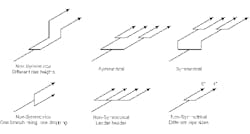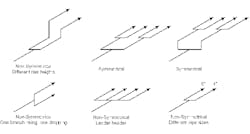Do Liquid Injection Right
Many processes require injecting liquid into a gas stream. Examples include introducing reactants, corrosion-control additives, and water or solvent to dissolve deposits. Questions often arise on how to do this properly. Both process and mechanical requirements set the overall constraints of a specific installation.
[pullquote]A recent example illustrates which factors to consider for successful liquid injection. A plant needed to inject water to dissolve salts being deposited from a vapor stream onto pipes and heat exchangers. Left in place, the salts caused under-deposit corrosion that created a leak in an exchanger.
Major factors evaluated for this installation included:
• type of injection device (quill, sparger or spray nozzle);
• direction of injection (co-flow or counter-flow);
• plane of injection (vertical or horizontal);
• flow regime or velocity needed for effective dispersion;
• mechanical and corrosion consequences of injection; and
• symmetry of downstream piping.
Every mixing job will have its own balance of requirements. However, the choices made in this specific case are instructive.
Historically, two streams most commonly were mixed using a T-connection. This still is often done. However, some type of quill or liquid distribution device performs better in nearly all cases. If the intent is to wet the surface of the pipe, a quill generally is best. If the intent is to thoroughly mix the liquid and vapor, spray nozzles usually are best. Here, we wanted good mixing and coating of the pipe surface — and chose a quill.
Most injection systems are designed to introduce liquid co-current with the major flow direction. Counter-current injection sometimes is favored in the belief that liquid first going upstream then turning and going downstream gives more-thorough mixing. I've found this is unimportant for most applications — but wouldn't try to dissuade anyone adamant about using counter-current injection. Here, we opted for co-current.
The plane of injection can significantly affect performance. Vertical (downflow) injection generally gives much better vapor/liquid mixing. Many horizontal injection systems suffer from some degree of flow stratification. However, vertical injection poses many more problems due to erosion or corrosion from droplet impingement on the downstream piping — and thus may require impingement protection. This plant had no spot suitable for a vertical injection system, so we used horizontal injection.
Low gas velocity nearly always results in liquid stratification downstream of the injection. The most common rule of thumb is to have a minimum vapor velocity of 10 ft/s at the injection point. This ignores the effect of gas density, though. A more-sophisticated approach checks the downstream flow regime. A mist-annular flow regime is ideal. However, our flow regime predictions assume sufficient pipe downstream to get a stable flow pattern. I prefer to use an entrainment analysis based on a Souders-Brown c factor:
cSB = Vgas [ρgas/(ρliquid – ρgas)]½
where Vgas is vapor velocity in ft/s and the densities are in consistent units.
Using cSB accounts for gas density effects and also avoids the problem of using a correlation really meant for long pipe runs. The cSB at the injection point should exceed 1.0 for good distribution. This is based on much experience with distillation systems where factors over 0.45 show large amounts of liquid entrainment into the vapor. Many disengaging drums are designed at a 0.35 to 0.38 cSB to de-entrain liquid. At a cSB of at least 0.5 liquid mixing into the vapor starts to become significant. At a cSB of 1.0 liquid distribution in the gas becomes quite good, although not perfect.
For our situation, the cSB was 2.12 with a vapor velocity of 56.6 ft/s. Two-phase flow calculations showed operation comfortably in a "distributed" regime. For comparison, this system at 10 ft/s flow velocity would have a cSB of 0.38 and a predicted segregated flow pattern (Beggs-Brill). At 13.0 ft/s the cSB reaches 0.5, but a segregated flow pattern still is predicted. Vapor velocity has to rise to 50 ft/s with a cSB of 1.9 to reach a predicted distributed flow regime. For our case, the 56.6 ft/s velocity required no modifications regardless of the criteria. In other cases, low velocities may necessitate a smaller piping size for good mixing.
When injecting a liquid, consider erosion, corrosion and thermal stress. Erosion can result from direct impact of liquid. The interface zone, where the pipe may be wetted some times and dry other times, can pose a particular corrosion problem. Finally, if quenching occurs, thermal stresses in the pipe can cause major mechanical issues. For the case here, mechanical issues weren't difficult.
The situation is relatively simple if the piping network consists of a simple line. Problems occur with downstream branches. If you must distribute liquid through multiple branches, keep the piping as symmetrical as possible. Maintain the symmetry in both the horizontal and vertical planes and at every split. Figure 1 shows several examples of symmetrical and non-symmetrical piping. In non-symmetrical systems the liquid will concentrate toward the last part of the pipe that takes a turn. To avoid symmetry problems, the plant used separate injection points downstream of the last major branch in the line.
Your requirements may include other factors and pose much different tradeoffs than those here. So, delve into the particulars.
ANDREW SLOLEY is a Chemical Processing Contributing Editor. You can e-mail him at [email protected]

